

| Administrator Guide > Virtual Capture Overview > Virtual Capture Screen Designer |
The Screens page within System Management > Origination > Virtual Capture > Screens provides a complete list of all screens used within Virtual Capture. From this page, administrators are provided with the functionality to define the screens that optimize usability and reduce application processing time for the applicant.
 |
Each time the details within a user-defined screen are saved during the create, copy, or edit process, a screen definition including the panel layout, fields, and Editability properties is stored in the database. To ensure the security of the information in user-defined screens, a unique token is generated each time a manually created screen is saved in Virtual Capture. During the save process, the token reviews the screen definition, and then reviews Editability to determine which fields are editable in the screen, and should be included in the token. Any fields from the screen definition that are not editable, or fields from the screen DTO that are not a part of the screen definition, are excluded from the token to ensure they are ignored during the save process, and prevented from being accessed in the screen.
|
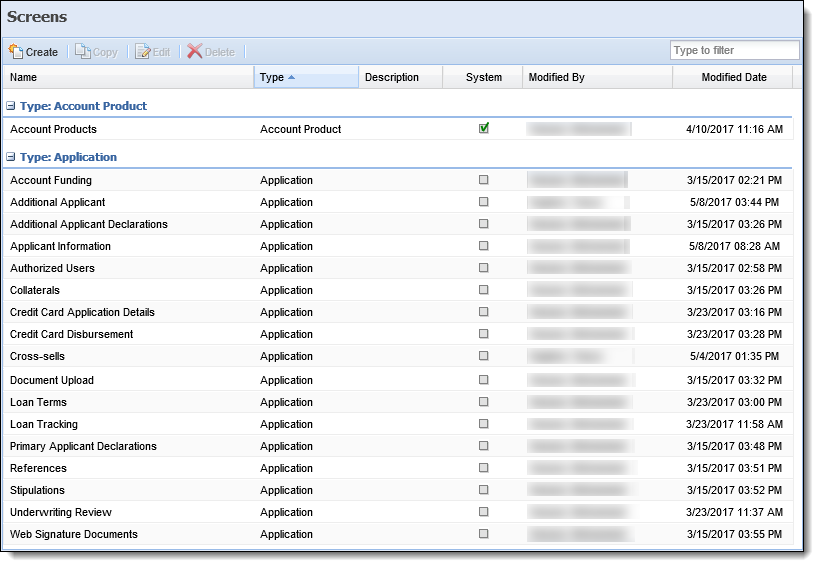
By default, the Screens page sorts all existing screens according to screen type, and displays information about each screen within the following columns:
| Column Name | Description |
| Name | Displays the name of the screen. |
| Type | Displays the type of screen. |
| Description | If provided, displays a description of the screen. |
| System | Displays a  if the screen is system-defined. if the screen is system-defined. |
| Modified By | Denotes who made the last modification. |
| Modified Date | Denotes when the last modification was made. |
Users are able to configure how screens are sorted and displayed within the Screens page. To update these options, click the drop-down arrow next to any column header.Select from the following sorting/display options:
 |
To further assist users with locating screens, a filter exists in the top right of the Screens page. Users may enter key words to search for the desired screen. |
| Option | Description | ||
| Sort Ascending |
Sorts the screens listed on the Screens page from A-Z.
|
||
| Sort Descending |
Sorts the screens listed on the Screens page from Z-A.
|
||
| Columns | Allows users to select the columns to be displayed on the Screens page. | ||
| Group By This Field | Allows users to group the listings within the Screens page by the selected column header. | ||
| Show in Groups | Select this check box to enable screens to be grouped on the Screens page. |
The Screen Designer topic includes the following attributes and instructions to assist administrators with creating, copying, and editing screens:
All Virtual Capture screens share common attributes that are defined when creating, copying, or editing a screen.
General attributes include the basic information pertaining to the screen.
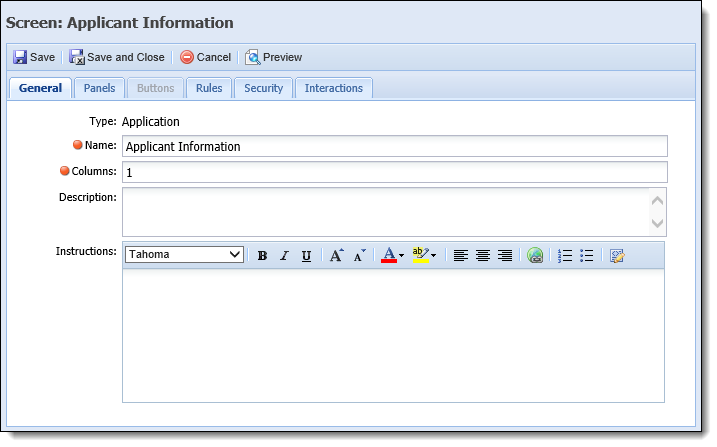
The following General attributes are defined within the General tab:
| Attribute | Description | ||
| Name |
Enter a unique name for the screen.
|
||
| Columns |
Enter the number of columns in which the panels display.
|
||
| Description | Enter a description that identifies the purpose of the screen. | ||
| Instructions |
Enter instructions that help the user complete the screen. When instructions are configured, they appear on the right hand side of the Virtual Capture screen.
|
Panels are added to user-defined screens to organize screen data into logical groupings. Panels can be used to not only display information pertinent to an application, but also provide applicants with the ability to enter important data during the application process all within the same screen.
Virtual Capture panels are categorized as either System-Defined or User-Defined. System-Defined panels provide pre-built functionality that cannot be modified or configured. A User-Defined panel has various configurable properties, such as the title, the number of columns that display, as well as the specific fields that appear within the panel.
The attributes for each panel are defined on the Panels tab. This tab displays an overview of each panel configured to appear on the screen, as well as provides administrators with the ability to Add, Edit, and/or Delete a panel.
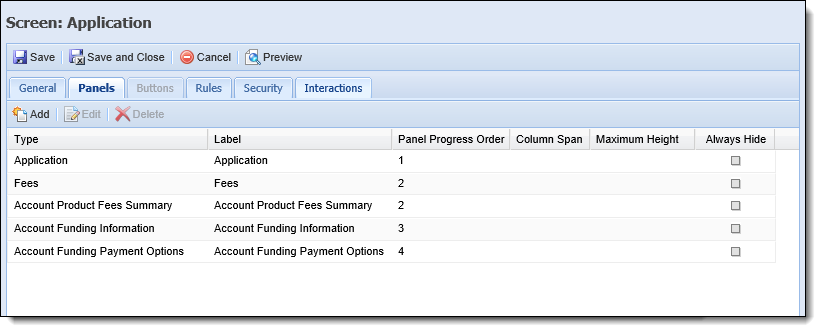
The grid within this tab displays the following panel attributes, as columns:
| Column | Description | ||||||||||||||
| Type | Read-only field that indicates the panel type or the panel's default name. | ||||||||||||||
| Label |
Read-only field that indicates the panel title that appears within Virtual Capture.
|
||||||||||||||
| Panel Progress Order |
Editable field that allows administrators to create a panel workflow within a Virtual Capture screen. Entering a value in this field determines the order in which a panel is presented to an applicant. Panels are presented in order, from the lowest to highest Panel Progression Order value.
To set the Panel Progression Order, click within each column and set the desired value for each panel.
When the Panel Progression Order is set, Virtual Capture applicants navigate through a screen's panels using the Continue and Previous buttons. When Continue is clicked, Virtual Capture displays the panel with the next lowest progression order. Once the last panel in the progression order has been reached, clicking Continue saves the screen, and displays the next screen in the workflow.
Clicking Previous navigates an applicant to the last screen or panel processed. If an applicant navigates to a different screen, and clicks Previous to return to a screen that uses Panel Progression Order, Virtual Capture displays the panel with the highest progression order.
|
||||||||||||||
| Column Span |
Read-only field that indicates the number of columns in which fields are organized.
|
||||||||||||||
| Maximum Height |
Read-only field that indicates the panel's maximum height.
|
||||||||||||||
| Always Hide |
Read-only field that indicates whether the panel is always hidden.
|
The following table provides an overview of each panel type, including a description of the panel, identification as a system-defined and/or grid panel, as well as the compatible screen type:
| Panel Type | Description | System-Defined | Grid | ||||||||||||
| Account Product Screen Type | |||||||||||||||
| Account Product |
A panel used to capture account product information.
|
||||||||||||||
| Applicant Screen Type | |||||||||||||||
| Additional Applicants |
A panel used to capture the demographics for an additional applicant on a virtual application, such as name, address, phone, and income information.
|
||||||||||||||
| Additional Applicant Declarations |
A grid panel used to display declaration questions for an additional applicant. From this panel, applicants are provided with the ability to answer the declarations and enter an explanation for each answer.
|
X |
|||||||||||||
| Application Screen Type | |||||||||||||||
| Account Funding Information |
A panel used to display a list of account products associated with an application and the initial deposit amount required to fund and open each account. Applicants have the ability to modify the funding amounts by entering any non-negative dollar amount within the amount field.
|
||||||||||||||
| Account Funding Payment Options |
A panel used to capture the payment information required to open the account products associated with an application. Based on the Payment Option selected, the corresponding form fields display to applicants for completion. If funding is not required, this panel does not display to applicants.
|
X |
|||||||||||||
| Account Product Fees Summary |
A read-only panel that displays a summary of all account product fees on a Virtual Capture application.
|
X |
|
||||||||||||
| Additional Applicant |
A panel used to capture the information specific to a Joint applicant or Guarantor, such as Name, TIN, Address, and Applicant Type. From this panel, applicants are provided with the ability to add and remove an additional applicant from a Virtual Capture application.
|
||||||||||||||
| Additional Applicant Declarations |
A grid panel used to display declaration questions for an additional applicant. From this panel, applicants are provided with the ability to answer the declarations and enter an explanation for each answer.
|
X |
|||||||||||||
| Additional Applicants |
A panel used to display each additional applicant on the application in a card view. From this panel, applicants are able to add, edit, and delete one or more additional applicants during the virtual application process.
|
X |
|||||||||||||
| Application | A panel used to capture all configurable application fields such as Applicant and Decision information. | ||||||||||||||
| Authorized User 1 | A panel used to capture general information for a primary applicant's first authorized user. | ||||||||||||||
| Authorized User 2 | A panel used to capture general information for a primary applicant's second authorized user. | ||||||||||||||
| Collateral - Real Estate |
A panel used to capture general collateral information for applications secured by Real Estate. In addition to the property's location and valuation data, this panel allows applicants to provide: Within Virtual Capture, applicants are able to provide up to three liens within this panel. When configuring the Collateral - Real Estate panel, institutions are able to assign fields for Lien 1, Lien 2, and Lien 3
Within Virtual Capture, applicants are able to provide real estate housing expenses within this panel. When configuring the Collateral - Real Estate panel, institutions are able to assign fields for the following housing expense types:
Within Virtual Capture, applicants are able to provide two Other Owners within this panel. When configuring the Collateral - Real Estate panel, institutions are able to assign name, address and contact information fields for Other Owner 1 and Other Owner 2.
|
||||||||||||||
| Collateral - Vehicle | A panel used to capture general collateral information for applications secured by a vehicle. | ||||||||||||||
| Cross-sells |
A panel used to display the account, loan, non-loan, and replacement cross-sells for which the applicant is qualified, as generated through rules.
|
X |
|||||||||||||
| Disclosure | A panel used to display a disclosure, such as Terms and Conditions, to the applicant for acknowledgement during the application process. Upon acknowledgement of the disclosure, a record is added to the Audit History screen in the Temenos Infinity application. | ||||||||||||||
| Document Sets |
A panel used to display document sets generated by IMM that are available through DropSpot, and have not been sent to a third party for remote signature. From this panel, applicants are able to download and print the documents during the virtual application process.
|
X |
X |
||||||||||||
| Document Upload |
A grid panel used to display general documents, such as images of driver's licenses and W2 forms, that are associated with an application. From this panel, applicants are provided with the ability to upload additional documents, as well as view all documents associated with the application.
If accessing the Document Upload panel from a smartphone or tablet with a camera, the applicant has the option of taking and uploading a new photo of the document to the application.
|
X |
X |
||||||||||||
| Fees |
A grid panel used to display loan application fees. From this panel, applicants are provided with the ability to select the fees they wish to include in the total loan amount.
|
X |
X |
||||||||||||
| HMDA | A panel used to capture the information specific to HMDA reportable loans such as applicant ethnicity and gender. | ||||||||||||||
| ID Authentication |
A panel used to display KBA questions from FIS ChexSystems for a primary applicant. From this panel, applicants are provided with the ability to answer the identity verification questions.
|
X |
|||||||||||||
| Liabilities |
A panel used to capture and display liabilities for the application.
When assigning this panel to an Application screen, all Liability-level fields are available to be added by the system administrator.
|
X |
|||||||||||||
| Loan Covenants | A read-only panel that displays a list of the loan covenants on an application. This panel displays the Name, Duration, Validation Frequency, and Next Due Date for each loan covenant with Is Waived set to false. |
X |
X |
||||||||||||
| Loan Funding |
A panel that provides users the ability to set the funding type of loan applications.
|
X |
|||||||||||||
| Primary Applicant |
A panel that captures the information specific to the Primary Applicant such as Name, Address, Phone, Employment, and Income Information.
|
||||||||||||||
| Primary Applicant Declarations |
A grid panel used to display declaration questions for a primary applicant. From this panel, applicants are provided with the ability to answer the declarations and enter an explanation for each answer.
|
X |
|||||||||||||
| Promotions |
A panel used to display the promotional offers for which an applicant is eligible in Virtual Capture.
|
X |
|||||||||||||
| Recurring Fees | A read-only panel that displays a list of the recurring fees on a loan application. This panel displays the Fee Name, Amount, and Assessment Frequency for each recurring fee on the application with Is Waived set to false. |
X |
X |
||||||||||||
| Reference 1 | A panel used to capture and display an applicant's first reference. | ||||||||||||||
| Reference 2 | A panel used to capture and display an applicant's second reference. | ||||||||||||||
| Rich Text | A panel that is able to display an informational/instructional message configured by the institution. The instructions section may also include hyperlinks. By default, hyperlinks open within Virtual Capture; however, hyperlinks may be configured to open in a new window. For more information on configuring hyperlinks to open in a new window, see Hyperlink Help. | ||||||||||||||
| Stipulations |
A grid panel used to display the requirements associated with an application, such as proof of insurance.
This panel displays a row in the grid for each stipulation associated with the application, including those that have been met. The related document(s) are listed from newest to oldest in a separate row under each stipulation.
From this panel, applicants are provided with the ability to not only view the documents associated with a stipulation, but also upload stipulation documents, and/or delete documents.
If accessing the Stipulations panel from a smartphone or tablet with a camera, applicants also have the option of taking and uploading a new photo of the document to the application.
For more information on Stipulations, please see the Stipulations Panel topic in the End User Guide. |
X |
|||||||||||||
| Web Signature Documents | A panel used to display the documents to be signed using a third party remote signature connector. |
X |
|||||||||||||
The following attributes can be defined when creating, copying, and/or editing panels:
The General panel attributes enable administrators to edit the appearance of the panel, as well as provide instructions to applicants.
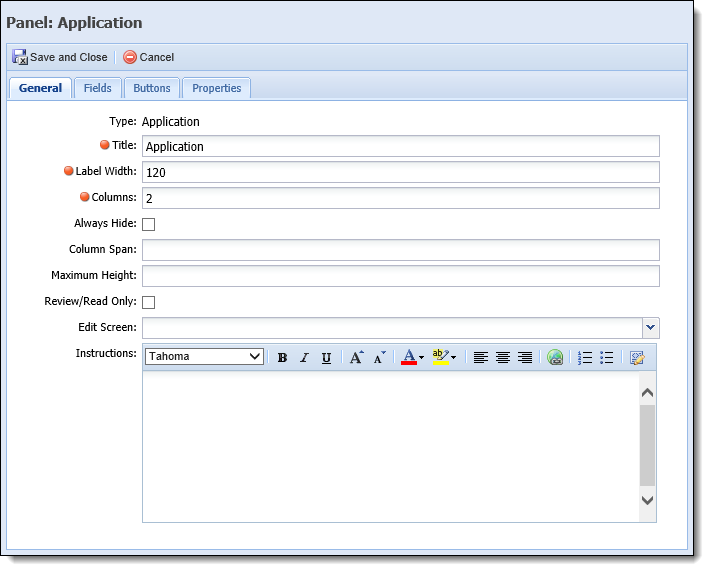
The following General panel attributes are defined within the General tab:
 |
The above image displays an example of how the General tab may appear when configuring a panel for a Virtual Capture screen. Some fields within the General tab vary according to the panel type; therefore, not all of the fields listed in the below table are available for each panel. |
| Attribute | Description | ||||||
| Title | Enter the title assigned to the panel within the screen. | ||||||
| Label Width |
Enter the maximum number of pixels the label width is not to exceed. The lower the number, the more area available for entries in the associated fields.
|
||||||
| Columns |
Enter the number of columns in which fields are organized.
|
||||||
| Collapsed By Default |
Select the check box if this panel is to be collapsed by default.
|
||||||
| Always Hide |
Select the check box if this panel is never to be displayed on a screen.
|
||||||
| Hide If Empty |
Select the check box to hide the panel in a virtual application when there is no information to display for the applicant.
For example, if there are no Stipulations that need to be fulfilled for an applicant, and the Hide If Empty check box is selected for the Stipulations panel, the panel does not appear in the screen in Virtual Capture. If the Hide If Empty check box is not selected for the above panels, and there is no information to display for the applicant, a blank panel is presented to the applicant in Virtual Capture.
|
||||||
| Column Span |
Enter the number of columns a panel spans within a screen.
|
||||||
| Maximum Height |
Enter the maximum number of pixels the panel height may not exceed.
|
||||||
| Review/Read Only |
Select the check box to designate the panel as a review or read-only panel. Upon selecting this check box, an Edit Screen must be assigned to the panel.
|
||||||
| Edit Screen |
Use the drop-down list to select the Edit Screen that opens when
|
||||||
| Instructions |
Enter a Rich Text set of instructions to assist users in completing the panel. When instructions are configured for the panel, an
|
 |
The Fields tab is available for the following panels:
|
Field attributes provide the administrator with the ability to configure style attributes and perform the following functions:
| Button | Description | ||||
 |
Enables users to select the fields to be added to the panel from the field list.
|
||||
 |
Enables users to add spacer fields to the panel. Spacer fields help organize and align fields into logical groupings. | ||||
 |
Enables users to add text fields to the panel. Text fields help organize panels into logical groupings by serving as headings within a panel. Text fields display information in bold font. | ||||
 |
Enables users to add a blank line that spans the width of a panel. Line fields help organize fields into logical groupings. |
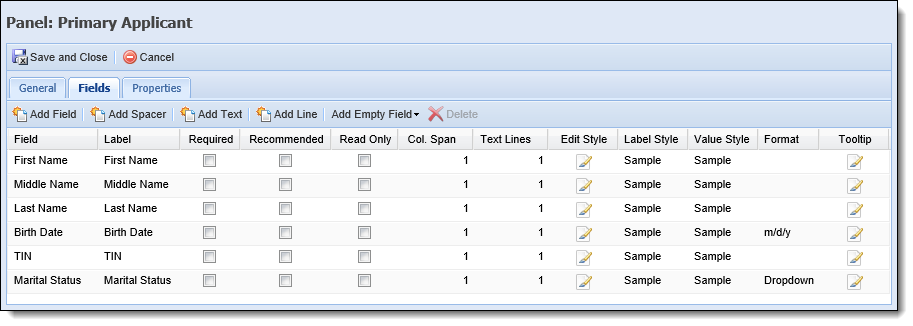
The following Field attributes are defined within the Fields tab:
| Attribute | Description | ||||||||||||||||||||||||||
| Label |
Enter the title of the field to be displayed within the panel/screen.
|
||||||||||||||||||||||||||
| Required |
Select this check box if the field must be completed in order to continue processing the application. Required fields display a
|
||||||||||||||||||||||||||
| Recommended |
Select this check box if the completion of a field is suggested. While the screen can be saved if recommended fields are left blank, this functionality can be beneficial in ensuring all necessary information in obtained.
|
||||||||||||||||||||||||||
| Read Only |
Select this check box to restrict the user from editing the value contained within the field. |
||||||||||||||||||||||||||
| Col. Span |
Enter the number of columns the field spans within a panel.
|
||||||||||||||||||||||||||
| Text Line | Enter the number of lines the field and its corresponding entry encompass. | ||||||||||||||||||||||||||
| Edit Style |
Click The Clicking
The following Style attributes are defined within the Edit Style window:
Upon saving the style attributes, samples of the Label Style and Value Style are displayed within the grid.
|
||||||||||||||||||||||||||
| Label Style | A non-editable column that allows the administrator to preview the Label text style defined in the Edit Style window. | ||||||||||||||||||||||||||
| Value Style | A non-editable column that allows the administrator to preview the Value text style defined in the Edit Style window. | ||||||||||||||||||||||||||
| Format |
Select the format to apply to a date field, or a lookup field in the panel. This column defaults to a format of m/d/y for date fields, and Dropdown for lookup fields, but can be changed by selecting a value from the corresponding drop-down list.
Reference the following sections for an overview of the formats that can be set within this column for date fields and lookup fields in a Virtual Capture screen: Within the Format column, date fields can be configured to display in one of the following formats in a Virtual Capture screen:
To see these date field formats in action, watch the following video: Within the Format column, lookup fields can be configured to display in one of the following formats in a Virtual Capture screen:
To see these lookup field formats in action, watch the following video: |
||||||||||||||||||||||||||
| Tooltip |
An editable column that allows the administrator to enter a description or directions for each field added to a panel. Click  to open the Tooltip to open the Tooltip
window where text can be entered to provide information about the field in the screen.
Reference the following section for an overview of the Tooltip window: Upon clicking
Once the desired text has been entered, click
|
 |
For more information on the Edit Style, Label Style and Value Style column, please see the below Edit Style section. |
 |
The Buttons tab only displays for Application panels. |
Buttons provide the ability to perform an action directly within a panel. Button attributes for a panel are defined within the Buttons tab. This tab enables administrators to add and delete panel buttons, as well as lists the name of each button configured to appear on the panel.
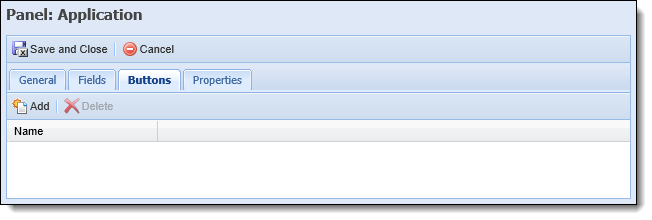
The table below lists the buttons available to be assigned to a Virtual Capture panel:
| Button | Description |
| Calculate | Allows users to calculate the values entered within the panel. In addition to saving and calculating the values entered, clicking Calculate also refreshes the panel to display the updated values in Virtual Capture. |
 |
The Properties tab only displays for the following panels:
|
Property attributes for a panel are defined within the Properties tab. The appearance and behavior of this tab differs by panel type, and may also differ according to fields configured to appear in a panel. Depending on the panel being configured, this tab may provide system administrators with the ability to determine the visibility of the panel within a virtual application, identify the options that are available for selection within the panel, and/or define messages to be displayed to applicants when the panel renders in Virtual Capture.
The following table provides an overview of each Virtual Capture panel that supports the properties attribute, including a description of the functionality configured within the Properties tab for each panel, as well as an example of how the tab appears for each panel:
| Panel | Properties Configuration | Example | ||||||
| Account Product | Allows system administrators to identify the account product(s) to be used by the panel. When the account product(s) assigned within the Properties tab are added to an application in Virtual Capture, the panel populates within the Account Products system screen in the virtual application. | 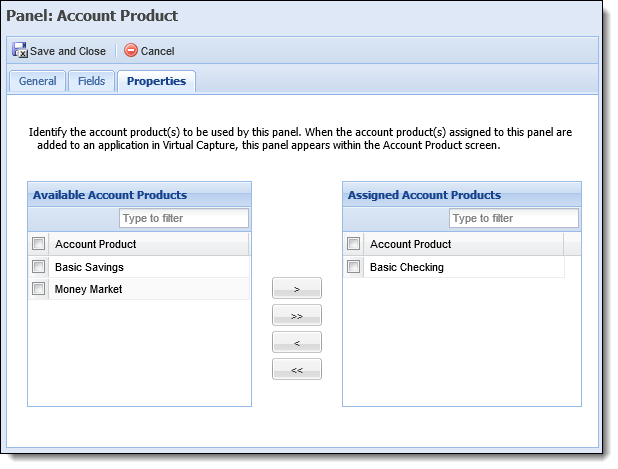 |
||||||
|
When the Check Image field is added to the Account Product panel, the Properties tab displays two sections: one to identify the account product(s) to be used by the panel, and another to configure the properties for the Check Image displayed in Virtual Capture. Within the Check Image Properties section, administrators are able to determine the required and optional fields available to add to a check in Virtual Capture, as well as configure the display order of the fields in the check image.
|
 |
|||||||
|
Account Products (Repeating) Authorized User 1 Authorized User 2 Collateral - Real Estate Collateral - Vehicle Reference 1 Reference 2 |
Allows system administrators to suppress  from displaying in panels. When this parameter selected, applicants are unable to remove an item from an application panel. from displaying in panels. When this parameter selected, applicants are unable to remove an item from an application panel. |
 |
||||||
| Account Funding Information | Allows system administrators to define the message to display within the panel when there are no account products on the application that require funding. | 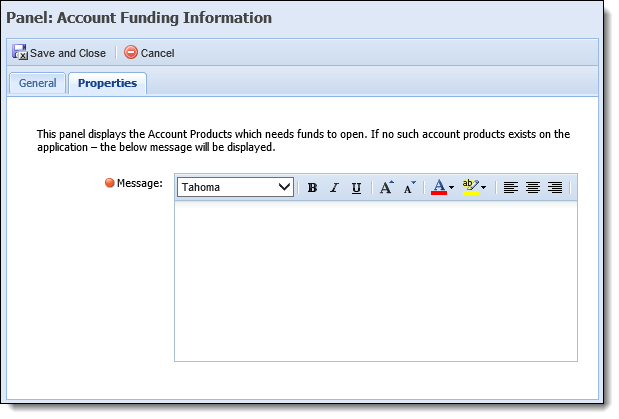 |
||||||
| Account Funding Payment Options |
Allows system administrators to determine which funding payment options are available for the panel in Virtual Capture, as well as hide the payment image for a single funding option, and define specific settings for credit cards and/or internal transfers.
|
|
||||||
|
Additional Applicant Application Primary Applicant |
Allows system administrators to determine when the panel appears in an application, based on the applicant's account holder status.
Allows system administrators to suppress |
 |
||||||
| Disclosure | Allows system administrators to define the message that populate when a disclosure is required for a virtual application. | 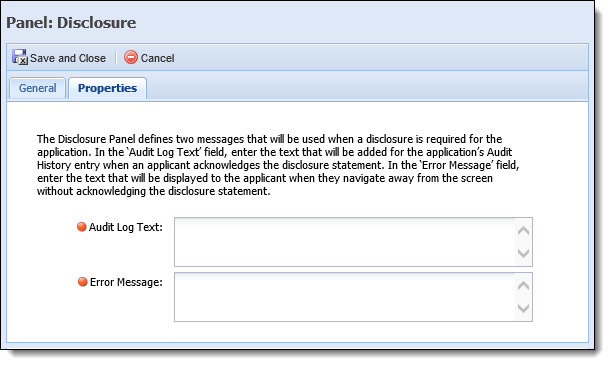 |
||||||
| Web Signature Documents | Allows system administrators to define the messages to be displayed when there are documents that need to be signed by the primary applicant, and when all of the document sets have been completely signed. | 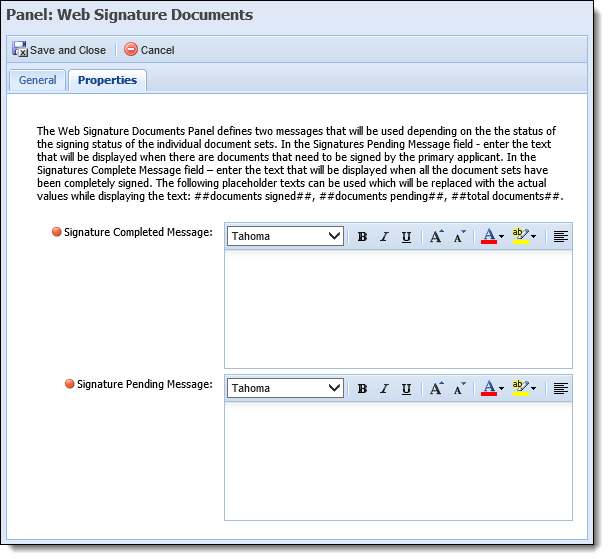 |
 |
The Columns tab only displays when a grid panel is being created or edited. If the Columns tab is available, at least one column must be assigned to the panel.
|
Column attributes enable administrators to customize the columns that appear within the grid panel.
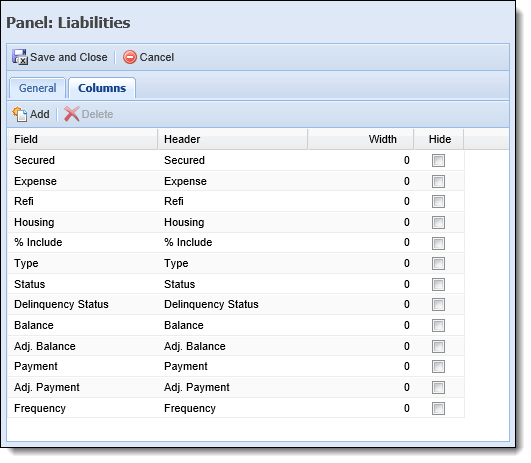
The following Column attributes are defined within the grid that displays in the Columns tab:
| Attribute | Description | ||||
| Field | Displays the name of the field selected to display as a grid column. This attribute is read-only. | ||||
| Header | Enter the title of the column to be displayed within the user-defined panel/screen. | ||||
| Width | Select the default pixel width of the column. | ||||
| Hide |
Select the check box if this column is never to be displayed within the panel.
|
 |
While the Buttons tab appears within the screen configuration window, the tab is disabled, as the functionality is not available for Virtual Capture screens. |
Validation Rules execute during the application process to validate and ensure that relevant and accurate data is entered within a screen. Upon execution, these rules automatically test the data entered within a screen and can be configured to issue an error, warning, or information message to prevent or continue the application process.
Rule attributes enable administrators to select Validation Rules from a list and assign them to the screen.
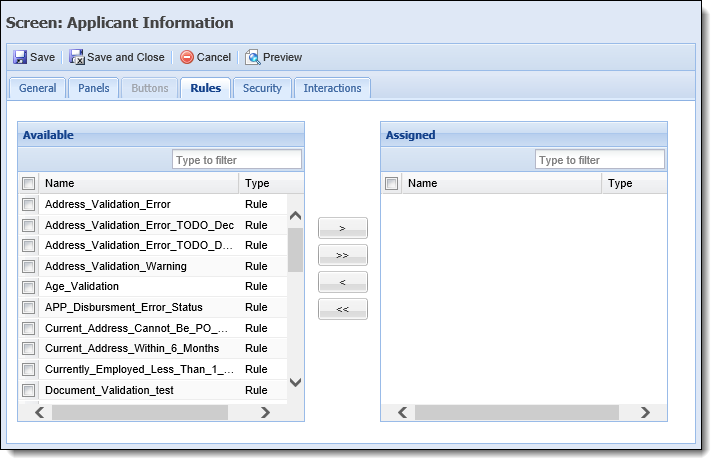
The following Rule attributes are defined within the Rules tab:
| Attribute | Description |
| Available | Displays a list of all Validation Rules configured in System Management > Origination > Rules Management. To assign a Validation Rule to the screen, select a rule from the list and move it to the Assigned box using the arrows that display. |
| Assigned | Displays a list of the Validation Rules assigned to the screen. The assigned Validation Rules execute when Save and Next is selected during the application process. |
 |
For more information on Validation Rules and other Rule Categories, please see the Rules Management topic within this guide. |
Security attributes allow administrators to assign the user-defined screen to specific Temenos Users and Security Groups.
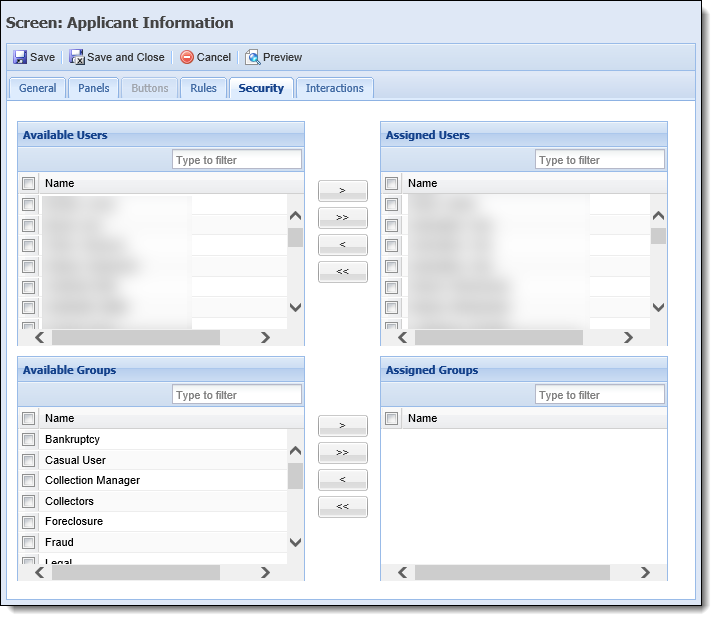
The following Security attributes are defined within the Security tab:
| Attribute | Description |
| Available | Displays a list of all Users configured in System Management > Users and all Security Groups created in System Management > Groups > Security Groups. Assign access to the screen by selecting the desired user(s) and group(s) from the list and moving the name(s) to the Assigned Users/Groups boxes using the arrows that display. |
| Assigned | Displays a list of the Users and Groups assigned access to the screen. Once the screen is saved, it is accessible to the assigned Users and Groups when processing an application. |
 |
For more information on User/Security Group permissions, please see the Users or Security Group topics within this guide. |
Interactions provide the ability to configure the conditions in which a screen's fields and panels are hidden from an application. This configuration allows institutions to ensure that only relevant fields and panels are displayed in an application.
 |
The Interactions tab is disabled for Account Product screen. |
 |
If a panel is hidden, as per screen interactions, the panel is excluded from the progress bar calculation. For more information, please see the Progress Bar section in the Virtual Capture Overview topic in this guide. |
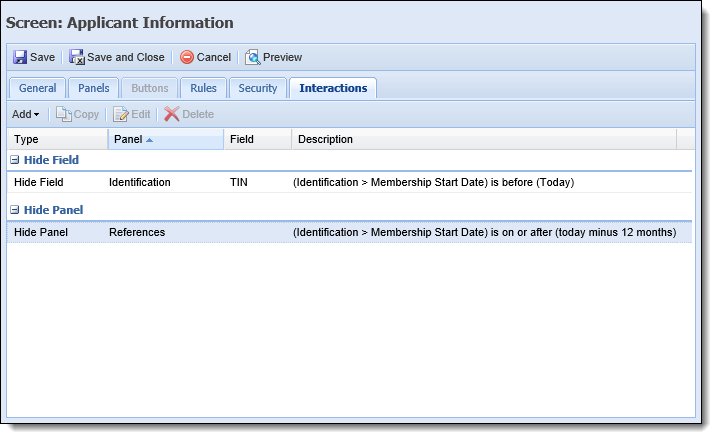
Screen interactions are maintained using the following action buttons:
| Button | Description | ||||||||||||||||||||||||||||
 |
Allows the administrator to create a new Interaction. Clicking
|
||||||||||||||||||||||||||||
 |
Allows the administrator to copy an existing interaction. | ||||||||||||||||||||||||||||
 |
Allows the administrator to edit an existing interaction. | ||||||||||||||||||||||||||||
 |
Allows the administrator to delete an existing interaction. |
The following attributes are defined within the grid that displays in the Interactions tab:
 |
All interactions for a screen are grouped together by type. Users are able to expand a grouping by clicking |
| Attribute | Description |
| Type | Identifies whether the interaction Type is Hide Field, Hide Lookup Value, Hide Panel, Hide Row, or Field Validation. |
| Panel |
The value within the Panel attribute is determined by the interaction type:
|
| Field |
The value within the Field attribute is determined by the interaction type:
|
| Description | Indicates the Interaction condition(s). |
To access the condition and expression builder, click  ,
,  , or
, or  . Within the condition and expression builder, administrators are able to identify the field, lookup value, or panel to be hidden, as well as the condition(s) that must be met for the interaction to occur.
. Within the condition and expression builder, administrators are able to identify the field, lookup value, or panel to be hidden, as well as the condition(s) that must be met for the interaction to occur.
Upon clicking  , administrators are presented with a selection window.
, administrators are presented with a selection window.
 |
If editing an existing interaction, administrators bypass the selection window, and are taken directly to the condition and expression builder. |
This window allows the administrator to:
 |
A separate selection window is presented for each interaction type. Reference the table below for an overview of the values that appear in the selection window for each interaction type:
|
For example, if Hide Field is selected, the following window appears to determine which field should be hidden when conditions are met in the application:

Click on the desired option to advance to the condition and expression builder.
The criteria defined within the condition and expression builder is comprised of the Groups, Conditions, and a Validation Message.
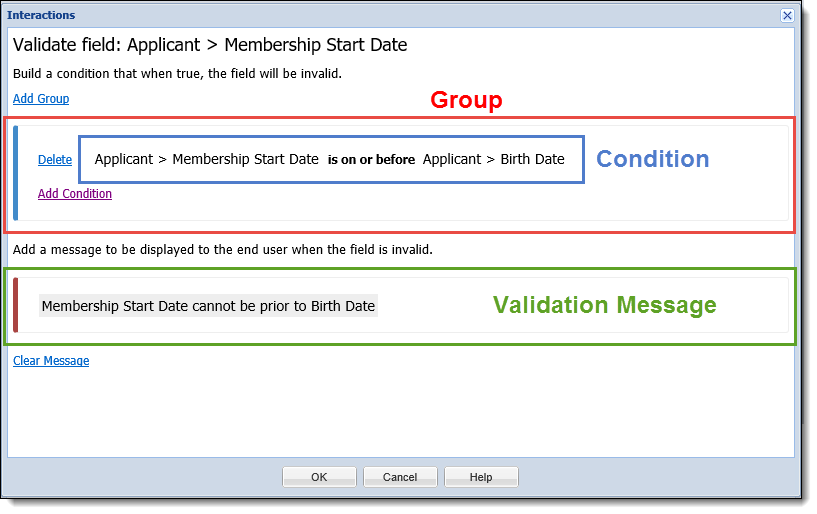
In the condition and expression builder, administrators may define one or more groups that may contain multiple conditions. If an interaction contains multiple groups, each group may be linked with an AND/OR relationship. Click  to begin authoring the hide condition(s). Once clicked, a new group is added to the Interactions pop-up window.
to begin authoring the hide condition(s). Once clicked, a new group is added to the Interactions pop-up window.
A group is a group of conditions, and at least one group must be defined for an interaction. Each group contains one or more condition, and administrators can define one or more groups that may contain multiple conditions. If an interaction contains multiple groups, each group may be linked with an AND/OR relationship.
 |
A screen interaction may contain an unlimited number of groups, and each group may contain an unlimited number of conditions. |
Click  to begin authoring the hide condition(s). Once clicked, a new group is added to the Interactions pop-up window.
to begin authoring the hide condition(s). Once clicked, a new group is added to the Interactions pop-up window.
 |
When creating a new interaction, one group is automatically added. |
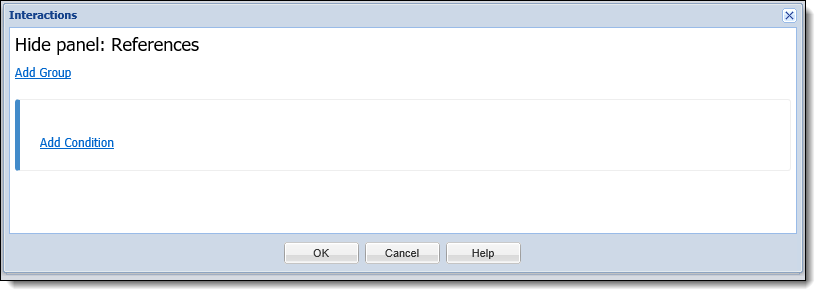
Within each group, administrators are able to perform the following actions:
| Action | Description |
 |
Allows administrators to add an interaction condition to the group. Upon clicking this button, a new condition is added to the group. When a new condition is added, the first field available in the screen populates in the left expression. Click on the left expression to open the field and function menu.
If a group contains multiple conditions, each condition may be linked with an AND/OR relationship. By default, the relationship is set to an AND relationship. Click on the AND to change it to OR. |
 |
Allows administrators to delete a condition from the group. Upon clicking this button, the condition is removed from the group. |
A condition is comprised of two expressions (a left and a right) that are linked by a relationship operator.
An expression is a calculation that returns a single value. Each expression can be comprised of one or more tokens, which may include a mixture of manually entered data, operators, fields, and functions. The following example contains seven tokens:

When building an expression, the following navigation capabilities are available:
 |
The keyboard arrow keys cannot be used to navigate through the field/function menu. |
Additionally, the following keys are supported for data entry:
| Keys | Description |
| Letters | All upper and lowercase letters from A to Z |
| Numbers | All numbers 0-9 |
| Space | The space bar |
| ( | Begin grouping |
| ) | End grouping |
| + | Add |
| - | Subtract |
| * | Multiply |
| / | Divide |
| \ | Forward slash |
| . | Period or decimal |
| = | Equal sign |
| ! | Exclamation |
| @ | At symbol |
| # | Number sign, pound sign, hashtag |
| $ | Dollar sign |
| % | Percent |
| ^ | caret |
| & | And symbol, ampersand |
| , | Comma |
| < | Less than |
| > | Greater than |
| ? | Question mark |
 |
Expressions are validated as they are authored. Invalid tokens are highlighted in red, and the errors are indicated in a tooltip when the cursor hovers over the exception.
|
When authoring an expression, administrators may select a field from the left side of the Field and Function menu. The fields available within this list are limited to those that are assigned to the screen.
 |
The Field and Function menu is accessed by clicking the equal sign (=) on the keyboard within a blank token, or clicking on an existing field or function in a token. |
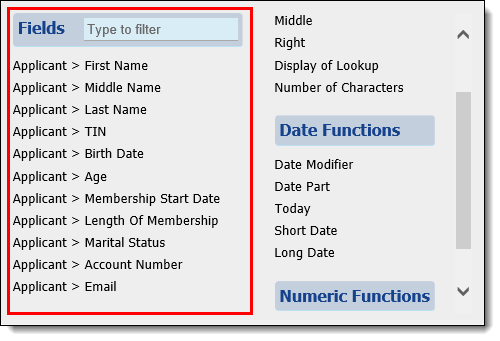
A Function is a token that uses one or more inputs to produce a single value. The following functions appear on the right side of the Field and Function menu:
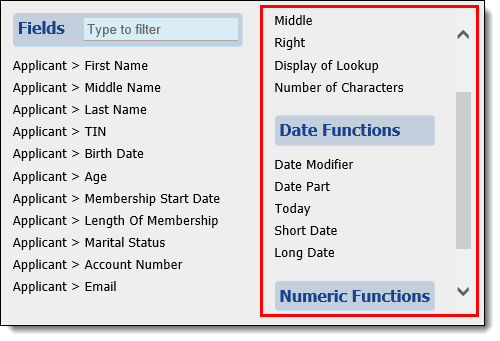
Upon selecting a function, the corresponding pop-up window opens. Within the function pop-up window, administrators are able to set the inputs to the desired values.
 |
The Today function does not require additional inputs to be configured, therefore a pop-up window does not open. |
Review the following table for an overview of the functions available within the condition and expression builder:
 |
Lookup fields are not compatible with the String functions for a Hide Row interaction. |
| Function Name | Description | Function Logic and Inputs | Function | ||||
| String | |||||||
| Contains |
Returns true or false, given whether the field contains the entered characters.
|
Contains (b) within (a)
|
|
||||
| Left | Returns the left-most characters. |
The left (b) characters of (a)
|
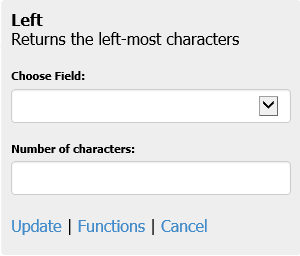 |
||||
| Middle | Returns a portion of the string with a given starting point and length. |
The middle (c) characters of (a), starting with.
|
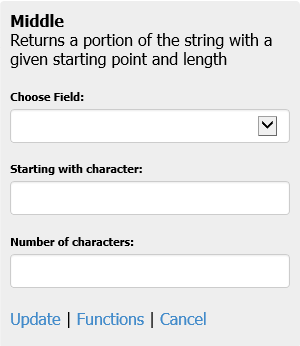 |
||||
| Right | Returns the right-most characters. |
The right (b) characters of (a)
|
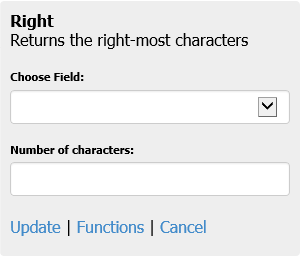 |
||||
| Display of Lookup | Returns the display of the lookup field. | Choose the lookup field. | 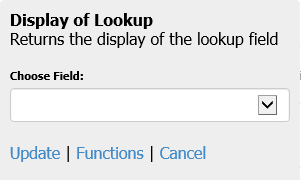 |
||||
| Number of Characters | Returns the number of characters in the given field. |
The number of characters in (a).
|
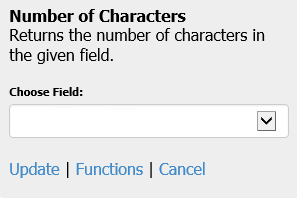 |
||||
| Date | |||||||
| Today | Returns today’s date. |
Today
|
|
||||
| Date Modifier | Returns a new date after applying modifiers to the original date. For example: Today minus 2 months, or BirthDate plus 18 years. |
(a)(b)(c)(d)
|
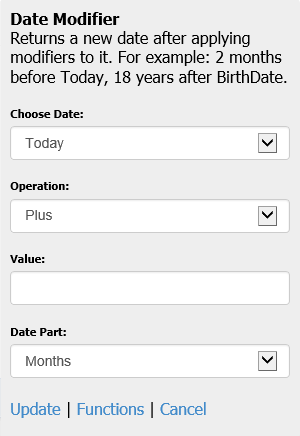 |
||||
| Date Part | Returns an integer representing a part of a given date (month, day, or year). For example: The month of 4/1/77 is 4. |
The (b) of (a)
|
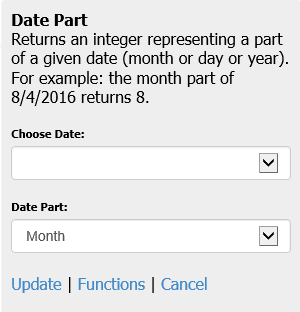 |
||||
| Short Date | Returns the selected short date format of the date field. |
Choose the date field. Choose the format:
|
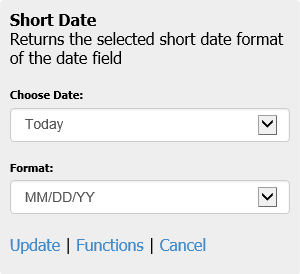 |
||||
| Long Date | Returns the long date format of the selected date field. | Choose the date field. | 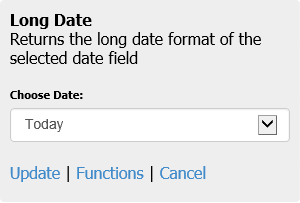 |
||||
| Numeric | |||||||
| Money | Returns the money format of the selected field. | Choose the field. | 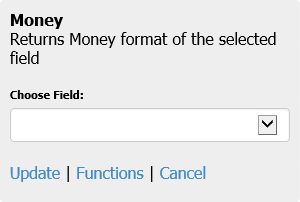 |
||||
| Decimal | Returns the decimal format of the selected field. |
Choose the field.
Enter the number of decimal places. |
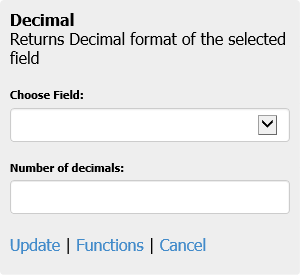 |
||||
 |
When a calculated field requires formatting, an empty field must be created to hold the calculated value, and the formatting needs to be applied to the empty field. |
In addition to setting the inputs, administrators are able to perform the following actions:
| Action | Description |
| Update | Saves the selections made in the function's pop-up window, and returns the administrator to the condition and expression builder. |
| Functions | Closes the function's pop-up window, discards all selections, and returns the administrator to the field and function menu. |
| Cancel | Closes the function's pop-up window, discards all selections, and returns the administrator to the condition and expression builder. |
The relationship operators available in a condition are based on the left expression's data type. For example, in the following image, the left expression is a date field and operators available are limited accordingly.
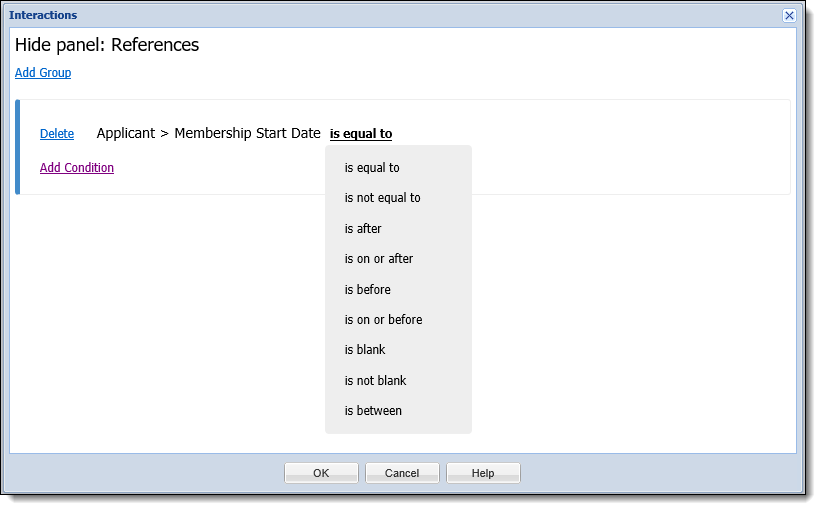
Refer to the following matrix for an overview of the relationship operators available with each data type:
| Operator |
Data Type |
||||
| Booleans | Dates | Strings | Lookups | Numerics | |
| Is equal to |
|
|
|
|
|
| Is not equal to |
|
|
|
|
|
| Is greater than |
|
|
|||
| Is greater than or equal to |
|
|
|||
| Is after |
|
||||
| Is on or after |
|
||||
| Is less than |
|
|
|||
| Is less than or equal to |
|
|
|||
| Is before |
|
||||
| Is on or before |
|
||||
| Is blank |
|
|
|
|
|
| Is not blank |
|
|
|
|
|
| Is between |
|
|
|||
 |
Reference the following list for an overview of information to consider for specific interactions and/or functions:
|
A Validation Message is a message that displays to the end user, if the value entered in the field does not meet the conditions identified in the Validate Field interaction.
 |
The Validation Message section only displays for Validate Field interaction types. |

Click within the message text box or press the Tab button to select the Message text box.
 |
Click |
 |
For more information on creating Interactions, please see the How to Create Screen Interactions topic. |
The Create function enables administrators to define the logic and structure of a user-defined screen. This function provides the ability to configure and customize all screen and panel attributes to meet an institution’s business needs.
 |
The Account Products screen is a system-defined screen; therefore, while the attributes of the screen can be modified by the system administrator, institutions are not able to create an Account Products screen type for Virtual Capture. For more information on the behavior of the Account Products system screen, please see the Account Products Screen and Panel Configuration topic in this guide. |
To design a user-defined screen, navigate to System Management > Origination > Virtual Capture > Screens and click  .
.
Select the following screen type from the Select Screen Type window:
| Screen Type | Description |
| Application | A screen type designed to capture information specific to the application (Applicant, Loan Terms, Collateral, Stipulations). |
Within the Edit Screen window, define the General screen attributes.
Once all General attributes are defined, navigate to the Panels tab to define panel attributes and perform one of the following actions:
To add a panel to the screen:
 within the Panels tab.
within the Panels tab. .
.To begin adding fields to the panel:
- Click
within the Fields tab.
- The Field Selector window appears displaying the available fields organized within a field tree format. Navigate through the folders and sub-folders to locate the desired field or enter the name of the field in the search box at the top of the Field Selector window.
- Double-click on the field or select
to individually assign it to the panel.
- After all fields have been added, click
to exit the Field Selector window and return to the Fields tab.
- Once added, the field populates within the grid that appears on the Fields tab.
When adding fields to a panel or screen, two of the same fields may exist within a screen, if the fields appear in two separate panels with different Properties; one panel set to Account Holder and the other set to Non-Account Holder. If the panels have the same Panel Visible For values, fields may only be added to a screen once. The exception to this rule is the Add Spacer/Text fields.
- The order in which the fields appear in the grid determines their order of appearance in the panel. Within the grid on the Fields tab, drag and drop the fields into the proper sequence. If desired, click
,
, and/or
to add Spacer, Text, and/or Line fields to the panel.
- Within the grid columns, define Field Label, Required, Recommended, Read Only, Col. Span, Label Style, Value Style, and Text Line attributes. For assistance with defining Label and Value Style attributes, click
.
If a screen is configured to collect identical information in two locations, such as when two different panels contain the same field, the field information within one panel may be overwritten by the data entered within the other panel when the screen is saved. To remove a field from a panel:
- Highlight the field within the grid in the Fields tab and click
.
When deleting a field, the system checks whether the field is included in a Validate Field interaction condition. If the field is included in a Validate Field interaction condition, a warning message displays that asks whether the field as well as all interactions using it should be deleted. Click Yes to delete the field as well as the interactions related to the field. Click No to keep the field as well as the interactions. To edit attributes for field label and/or field value style:
- Click
within the Edit Style column for desired field.
- The Edit Style window appears. Within this window, define Label and Value Style attributes.
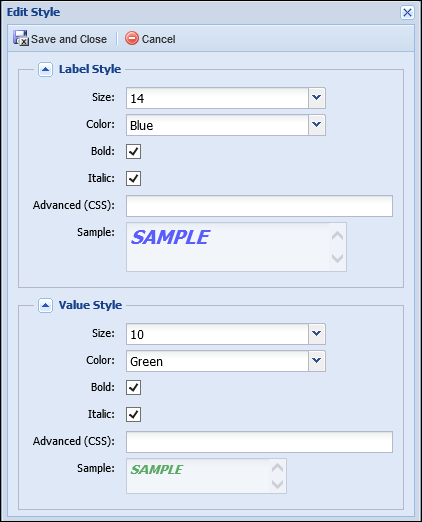
- When finished defining style attributes, click
. The Label Style and Value Style samples are displayed within the grid in the Fields tab.

- Upon completion of all panel attributes within the Edit Panel window, click
in the screen configuration window to return to the Panels tab.
- After returning to the Panels tab, users are able to define additional panels to be added to the screen or move on to the subsequent screen tabs.
 within the Edit Panel window
within the Edit Panel window Administrators are able to edit the panels of previously created screens.
To begin editing a panel:
 .
. within the Edit Panel window.
within the Edit Panel window. within the screen configuration window to finalize the panel modifications.
within the screen configuration window to finalize the panel modifications.
 |
Panel modifications are not saved until a final save is performed within the screen configuration window. |
Administrators are able to delete undesired panels from existing or in-progress screens.
To delete a panel:
 .
. within the screen configuration window to finalize the panel modifications.
within the screen configuration window to finalize the panel modifications.
 |
When deleting panels, the system does not display a confirmation message. When delete is selected, the panel is deleted. |
Once all panel attributes are defined, configure the Panel Progression Order within the grid on the Panels tab. To set the Panel Progression Order, click within each column and set the desired value for each panel.
 |
A value must be set for each panel. By default, the Panel Progression Order is set to 1 for each panel assigned to a screen. If a value is not set, an error message displays when saving the screen.
|
After the Progression Order has been determined, navigate to the Rules tab to assign Validation Rules to the screen.
After all rule attributes have been configured, assign Users and Security Groups access to the screen from the Security tab.
 |
If a User or Group is not specified, the new screen is not accessible to anyone processing an application. |
Navigate to the Interactions tab to Add, Copy, Edit, or Delete the following interaction types:
 , and select Hide Field.
, and select Hide Field. to identify the conditions in which the field is to be hidden on screen.
to identify the conditions in which the field is to be hidden on screen. , and select Hide Lookup Value.
, and select Hide Lookup Value. to identify the condition(s) in which the lookup values are hidden for the field.
to identify the condition(s) in which the lookup values are hidden for the field. and click Hide Panel
and click Hide Panel to identify the conditions in the panel is to be hidden on the screen.
to identify the conditions in the panel is to be hidden on the screen. and click Hide Row.
and click Hide Row. and identify the conditions in which rows within the panel are to be hidden.
and identify the conditions in which rows within the panel are to be hidden. and click Validate Field.
and click Validate Field. and identify the conditions in which the value entered in the field is invalid.
and identify the conditions in which the value entered in the field is invalid.Upon completion of all screen attributes, click  for a view of the completed screen. A preview window appears displaying a rendition of the screen. When finished previewing the screen, close the preview window, and, if necessary, make any changes to the screen.
for a view of the completed screen. A preview window appears displaying a rendition of the screen. When finished previewing the screen, close the preview window, and, if necessary, make any changes to the screen.
 |
Previewing a screen can be done at any point during creation of the screen, but is important to perform just prior to clicking  . Doing so allows mistakes to be found before the screen is opened in the workspace. . Doing so allows mistakes to be found before the screen is opened in the workspace. |
 |
When check box (Boolean) fields are configured to appear on an Application screen for Virtual Capture, the appearance of the fields differs between the screen Preview, and when the screen renders in Virtual Capture. In the screen Preview, the text of Boolean fields displays to the left of the check box, while the text displays to the right of the check box in the Virtual Capture application. |
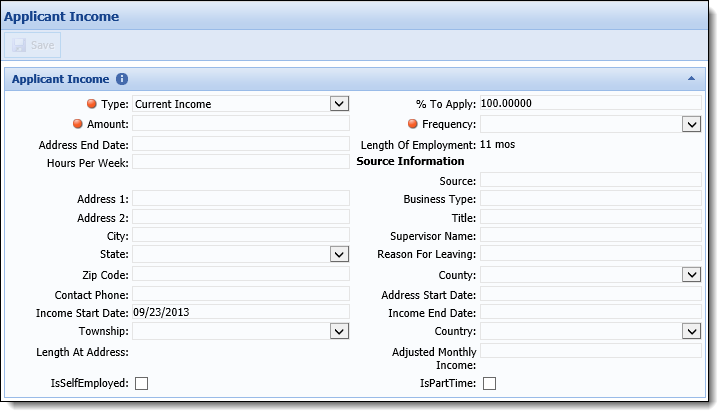
Once all configurations have been made to the user defined screen, click  within the screen configuration window to finalize the creation of the screen.
within the screen configuration window to finalize the creation of the screen.
The newly created screen populates within the grid on the Screens page and is available to display and capture data during the application process.
 |
Any changes made within the Virtual Capture Screens page are not applied in Virtual Capture until the web application is refreshed. By default, Virtual Capture is automatically refreshed every 30 minutes to apply the updated configurations to the Virtual Capture application.
|
The Copy function enables users to duplicate the logic and structure of an existing screen. The existing screen can be used as a base for creating a new screen. After copying a screen, users are able to add, modify, or delete screen logic and then save it with a different name in order to create a new user-defined screen.
 |
The Account Products system screen is not able to be copied; therefore, the  button is disabled when the screen is selected within the Screens grid. button is disabled when the screen is selected within the Screens grid. |
 .
. to retain the changes and finalize the creation of the new screen.
to retain the changes and finalize the creation of the new screen.The Edit function enables users to revisit an existing screen and modify the existing logic/structure to enhance usability.
 .
. to finalize the screen modifications.
to finalize the screen modifications.The Delete function enables users to remove an existing screen, and all of its logic from Temenos Infinity.
 |
The Account Products system screen is not able to be deleted; therefore, the  button is disabled when the screen is selected within the Screens grid. button is disabled when the screen is selected within the Screens grid. |
 .
.